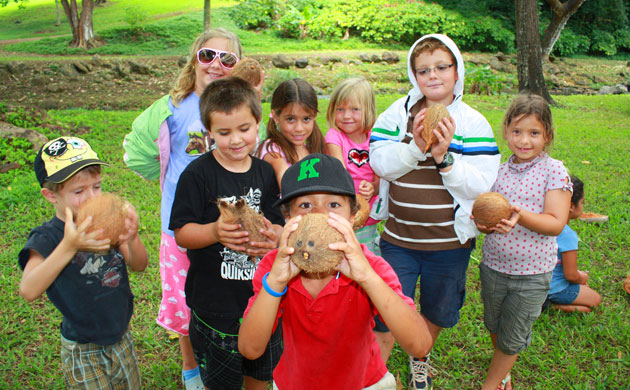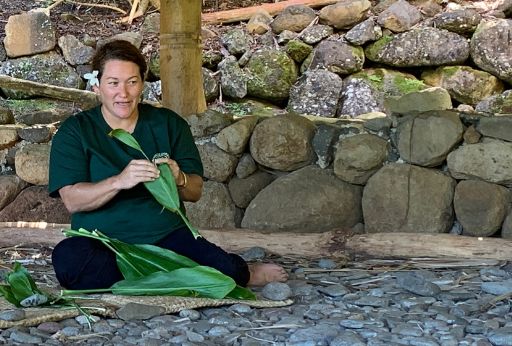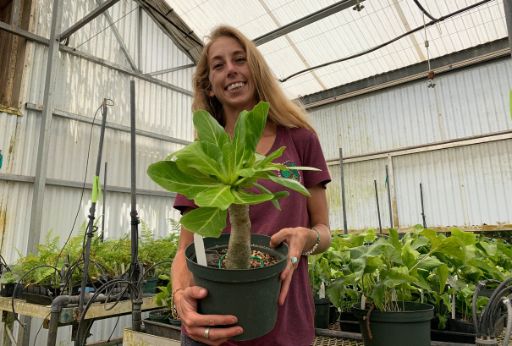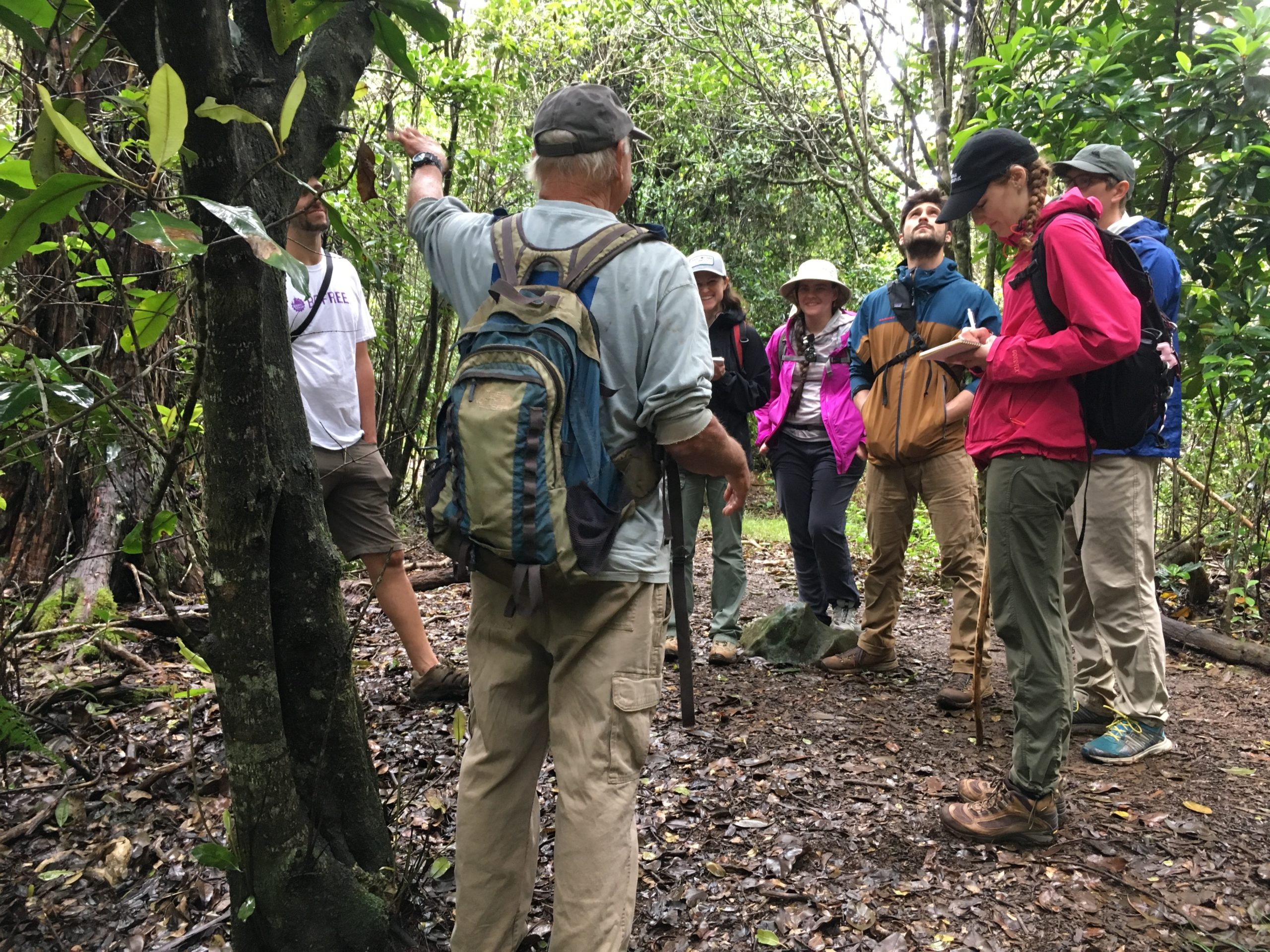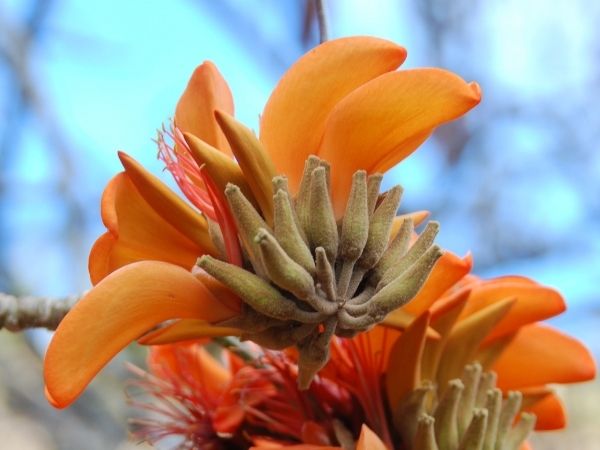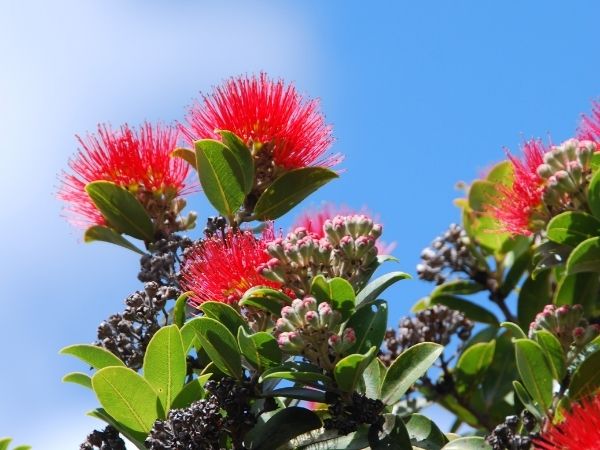Tropical Plant Database - Plant Details
Cordia subcordata
Click on any heading above to view more information about this plant
Conservation Status
- IUCN: least concern
- USFWS: None
Family: CORDIACEAE
Genus: Cordia
Species: subcordata
Species Author: Lam.
Vernacular: Kou, Tirakaumi [Fosberg 26134], Tou - Marquesan [Dunn 186]
Genus: Cordia
Species: subcordata
Species Author: Lam.
Vernacular: Kou, Tirakaumi [Fosberg 26134], Tou - Marquesan [Dunn 186]
Kou is an evergreen tree growing about 30 feet high with. It has a thick, wide-spreading crown, with light gray grooved and flaky bark. Within the trunk can be found a heartwood with beautiful colored markings that are reddish dark brown, sometimes with a hint of purple. The sapwood is straw color, with a tint of pink. In the medium soft and durable wood are grain markings, some straight and some of which are wavy with dark and light lines and bands of yellow. Kou leaves are smooth, large and oval, with a pointed end and rounded base. They are alternately arranged and are about 4 inches long. The leaf stem is 1/2 to 3 inches long. The leaves have wavy edges with prominent midrib and veins. The showy orange flowers of kou have no scent, and are one inch long, 1-2 inches across, with 5-7 lobes. They grow in clusters on short stalks, and are used as a lei flower. The fruit is nearly round, one inch long, growing in small clusters. The green fruit changes color to yellow and then to black as they dry and become hard. They contain a "stone" with 1-4 seeds.
(Wagner et al. 1999. Manual of Flowering Plants of Hawai'i.)
(Wagner et al. 1999. Manual of Flowering Plants of Hawai'i.)
Because of the beauty of its grain and the ease with which it can be cut and carved, true Kou is one of the best timber trees in Hawai'i. The wood of Kou is long-lasting with little shrinkage, medium-fine texture and the medium density. Therefore, large and stable vessels can be made from this wood essence. These were usually carved by the same men who made the wa'a, the canoes. These men knew how to season and how to gracefully shape the woods they used for the best and most practical purposes, and how to finish them so that a fine patina was achieved and their beauty would endure. Because of the good workability of Kou, it is fashioned into 'umeke la'au, containers of wood, crafted with great skill, as well as being aesthetically pleasing. 'Umeke kou, food bowls, and specifically poi bowls called 'umeke 'ai, platters called pa kou, cupps and serving dishes of kou were all preferred, because there is no unpleasant taste in the sap that would flavor food. Also made from Kou wood were canoes, paddles, back scratchers, calabashes and boxes, fish hooks, containers and other carved objects, such as images of deities.
Because of its thick wide crown of leaves, Kou was a favorite shade tree near home sites. Beneath its cool shelter, the women beat the kapa cloth or would string lei made also from the beautiful orange-red flowers of Kou, as they shared the day together.
In the old days Kou leaves were used to make a brown dye that was applied in designs on kapa. It is said that banyan (ficus) fruit was added to Kou leaves to make a fine red dye for tapa cloth.
(Krauss, B. H. 1993. Plants in Hawaiian Culture.)
(Kepler, A. K. 1998. Hawaiian Heritage Plants.)
(Information for this species compiled and recorded by Camelia Cirnaru, NTBG Consultant.)
Because of its thick wide crown of leaves, Kou was a favorite shade tree near home sites. Beneath its cool shelter, the women beat the kapa cloth or would string lei made also from the beautiful orange-red flowers of Kou, as they shared the day together.
In the old days Kou leaves were used to make a brown dye that was applied in designs on kapa. It is said that banyan (ficus) fruit was added to Kou leaves to make a fine red dye for tapa cloth.
(Krauss, B. H. 1993. Plants in Hawaiian Culture.)
(Kepler, A. K. 1998. Hawaiian Heritage Plants.)
(Information for this species compiled and recorded by Camelia Cirnaru, NTBG Consultant.)
Kou is widespread throughout Polynesia and the entire Pacific region, tropical Asia and East Africa. Recent paleobotanical investigations by David Burney of the National Tropical Garden and collaborators have shown that kou is indigenous to Hawai'i.
(Krauss, B. H. 1993. Plants in Hawaiian Culture.)
(Kepler, A. K. 1998. Hawaiian Heritage Plants.)
(Krauss, B. H. 1993. Plants in Hawaiian Culture.)
(Kepler, A. K. 1998. Hawaiian Heritage Plants.)
Kou occurs in ancient legends of Polynesia, one of which suggests that Kou was one of the first trees created.
(Krauss, B. H. 1993. Plants in Hawaiian Culture.)
(Kepler, A. K. 1998. Hawaiian Heritage Plants.)
(Krauss, B. H. 1993. Plants in Hawaiian Culture.)
(Kepler, A. K. 1998. Hawaiian Heritage Plants.)
- 030882 - collected by F. R. Fosberg in 1946
- 051318 - collected by F. R. Fosberg in 1946
- 030880 - collected by F. R. Fosberg in 1952
- 013231 - collected by B. G. Decker in 1964
- 030883 - collected by Derral Herbst in 1972
- 030881 - collected by Derral Herbst in 1972
- 086136 - collected by Art Whistler in 1973
- 086138 - collected by Art Whistler in 1973
- 008915 - collected by B. G. Decker in 1974
- 086137 - collected by Art Whistler in 1975
- 086144 - collected by Art Whistler in 1976
- 086145 - collected by Art Whistler in 1980
- 086143 - collected by Art Whistler in 1980
- 086142 - collected by Art Whistler in 1980
- 095647 - collected by Robin B. Huck in 1984
- 066216 - collected by Art Whistler in 1985
- 066217 - collected by Art Whistler in 1985
- 022099 - collected by F. R. Fosberg in 1985
- 066218 - collected by Art Whistler in 1986
- 004106 - collected by Tim Flynn in 1987
- 027190 - collected by Jacques Florence in 1988
- 086141 - collected by Art Whistler in 1989
- 013174 - collected by Lynwood Hume in 1991
- 086140 - collected by Art Whistler in 1991
- 022109 - collected by L. Raulerson in 1991
- 036952 - collected by Derral Herbst in 1992
- 041717 - collected by Art Whistler in 1993
- 086139 - collected by Art Whistler in 1993
- 022358 - collected by K. R. Wood in 1994
- 023683 - collected by Art Whistler in 1995
- 024634 - collected by Tim Flynn in 1997
- 034813 - collected by Michael J. Balick in 1997
- 027667 - collected by David H. Lorence in 1998
- 043941 - collected by Art Whistler in 1998
- 029397 - collected by Tim Flynn in 1999
- 086134 - collected by Art Whistler in 2000
- 086135 - collected by Art Whistler in 2000
- 042984 - collected by Art Whistler in 2000
- 035395 - collected by David H. Lorence in 2001
- 044394 - collected by Michael J. Balick in 2002
- 087503 - collected by A. Dores in 2002
- 038810 - collected by Hank Oppenheimer in 2003
- 039834 - collected by Liloa Dunn in 2003
- 039890 - collected by Liloa Dunn in 2003
- 043551 - collected by A. Dores in 2003
- 052548 - collected by Natalia Tangalin in 2004
- S046556 - collected by Tim Flynn in 2005
- 045539 - collected by Hank Oppenheimer in 2006
- 074902 - collected by David H. Lorence in 2016
- 093263 - collected by Gregory M. Plunkett in 2016
- 075937 - collected by Mike DeMotta in 2017
- 089039 - collected by David H. Lorence in 2018
- 093064 - collected by Gregory M. Plunkett in 2019
- 094585 - collected by Natalia Tangalin in 2020
- 090789 - collected by Uma Nagendra in 2022
- 095349 - collected by Elliot Gardner in 2022
We currently have 56 herbarium specimens for Cordia subcordata in our collection. Click on any specimen below to view the herbarium sheet data.
.svg)









